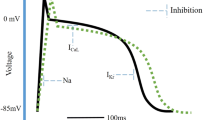Summary
We have studied 27 patients on long-term treatment (6–60 months) with amiodarone (dose range 350 mg per week to 2800 mg per week) to ascertain whether the corrected QT interval could predict plasma amiodarone or plasma desethylamiodarone concentration. The patients were assessed on three or four occasions one month apart.
There were positive correlations for Δ% QTc and plasma amiodarone and Δ% QTc and plasma desethylamiodarone.
There was approximately a four-fold variation for Δ% QTc and plasma amiodarone. This variation was not accounted for by between-occasion variation in the QTc interval, as the coefficient of variation was 2.1%. In six of the patients Δ% QTc either decreased or did not change.
Δ% QTc is not a reliable predictor of plasma amiodarone concentration in the individual patient over time.
Similar content being viewed by others
References
Raeder EA, Podrid PJ, Lown B (1985) Side-effects and complications of amiodarone. Am Heart J 109: 975–983
Staubli M, Bircher J, Galeazzi RL, Remund H, Studer H (1983) Serum concentrations of amiodarone during long term therapy. Relation to dose, efficacy and toxicity. Eur J Clin Pharmacol 24: 485–494
Pritchard DA, Singh BN, Hurley PJ (1975) Effects of amiodarone on thyroid function in patients with ischaemic heart disease. Br Heart J 37: 856–860
Debbas NM, du Cailar C, Bexton RS, Demaille JG, Camm AJ, Puech P (1984) The QT interval: A predictor of the plasma and myocardial concentrations of amiodarone. Br Heart J 51: 316–320
Reid DS (1980) The electrocardiogram in the assessment of the effect of drugs on cardiac arrhythmias. In: Shanks RG (ed) Methods in clinical pharmacology I. Cardiovascular system. Macmillan Journals Ltd, pp 46–58
Bazett HC (1920) An analysis of the time-relations of the electrocardiogram. Heart 7: 353–370
Bryson SM, Whiting B, Lawrence JR (1978) Disopyramide serum and pharmacologic effect kinetics applied to the assessment of bioavailability. Br J Clin Pharmacol 6: 409–419
Heger JJ, Solow EB, Prystowsky EN, Zipes DP (1984) Plasma and red cell blood concentrations of amiodarone during chronic therapy. Am J Cardiol 53: 912–917
Siebers RWL, Chen CT, Maling TJB (1986) HPLC determination of amiodarone and its metabolite desethylamiodarone in plasma and erythrocytes. NZ J Med Lab Technol 40 (4): 162–163
Rosenbaum MB, Chiale PA, Halpern MS (1976) Clinical efficacy of amiodarone as an antiarrhythmic agent. Am J Cardiol 38: 934–944
Singh BN (1983) Amiodarone: Historical development and pharmacologic profile. Am Heart J 106: 788–797
Gammage MD, Franklyn JA (1986) Amiodarone and the thyroid. Br J Clin Practice 40 [Suppl 44] 67–70
Author information
Authors and Affiliations
Rights and permissions
About this article
Cite this article
Burgess, C.D., Siebers, R.W.L., Purdie, G.L. et al. The relationship between the QT interval and plasma amiodarone concentration in patients on long-term therapy. Eur J Clin Pharmacol 33, 115–118 (1987). https://doi.org/10.1007/BF00544553
Received:
Accepted:
Issue Date:
DOI: https://doi.org/10.1007/BF00544553




